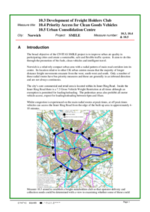Establishing an urban transhipment centre
Thematic areas
Urban logistics
- Distribution consolidation schemes
- Fleet management
- Urban freight transport plans
Summary
Optimising urban goods deliveries and using clean and energy-efficient vehicles can contribute to reducing congestion, emissions and noise in the city centre.
Implementing sustainable mobility
Norwich is a relatively compact urban area with a radial pattern of main road corridors. The city’s core commercial and retail area is located within the inner ring road where there is a weight restriction at all times, although an exemption is permitted for loading and unloading. Prior to measure implementation, goods vehicles were not allowed to use transport priority lanes and there was no urban consolidation centre.
The overall aim of the measure was to reduce the number of freight vehicle movements in the urban area, and in the city centre in particular, by consolidating loads and ensuring that deliveries are made by vehicles with low-emission engines (Euro 3 standard or higher). No changes to access and loading restrictions in the city centre were planned as part of the measure.
Progress
The measure was implemented though a partnership between Norfolk County Council and logistics company Foulger Transport. The partnership was established in May 2007 following a competitive procurement process.
Foulger operates a transhipment centre at its Snetterton site, just outside Norwich. Freight operators making deliveries to Norwich via the A11 can deliver to the transhipment centre warehouse, saving time and mileage. Where possible, Foulger combines loads when making the final deliveries, using vehicles already making deliveries to customers in Norwich.
Foulger employed a development manager to promote the transhipment centre and engage with businesses to recruit customers. This position was funded by CIVITAS. The first delivery from the transhipment centre was made in October 2007.
Outcomes
By December 2008, almost 200 initial customer contacts had generated 29 requests for quotations, leading to the recruitment of four customers (three retailers and one industrial customer).
Although the measure achieved limited success in terms of customer recruitment, there was a high level of satisfaction with the service among existing customers.
There was some success in switching urban deliveries to smaller goods vehicles.
Permitting vehicles making deliveries from the transhipment centre to use a bus lane in the city resulted in an average peak journey time saving of 1.8 minutes, with small related beneficial impacts on fuel consumption and emissions.









